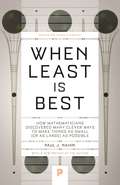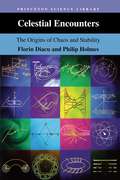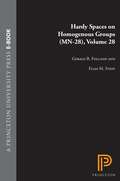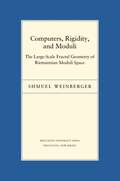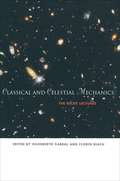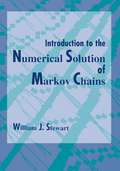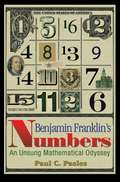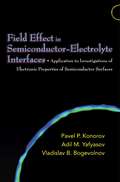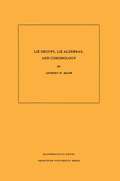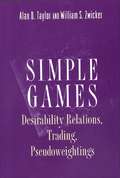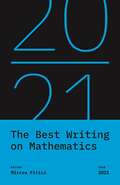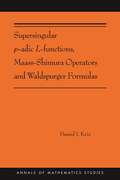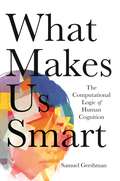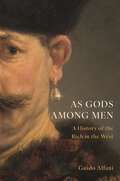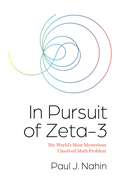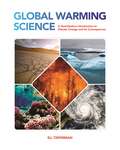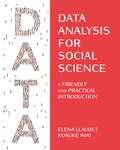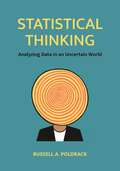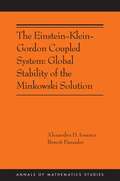- Table View
- List View
When Least Is Best: How Mathematicians Discovered Many Clever Ways to Make Things as Small (or as Large) as Possible (Princeton Science Library #118)
by Paul J. NahinA mathematical journey through the most fascinating problems of extremes and how to solve themWhat is the best way to photograph a speeding bullet? How can lost hikers find their way out of a forest? Why does light move through glass in the least amount of time possible? When Least Is Best combines the mathematical history of extrema with contemporary examples to answer these intriguing questions and more. Paul Nahin shows how life often works at the extremes—with values becoming as small (or as large) as possible—and he considers how mathematicians over the centuries, including Descartes, Fermat, and Kepler, have grappled with these problems of minima and maxima. Throughout, Nahin examines entertaining conundrums, such as how to build the shortest bridge possible between two towns, how to vary speed during a race, and how to make the perfect basketball shot. Moving from medieval writings and modern calculus to the field of optimization, the engaging and witty explorations of When Least Is Best will delight math enthusiasts everywhere.
Celestial Encounters: The Origins of Chaos and Stability (Princeton Science Library)
by Florin Diacu Philip HolmesCelestial Encounters is for anyone who has ever wondered about the foundations of chaos. In 1888, the 34-year-old Henri Poincaré submitted a paper that was to change the course of science, but not before it underwent significant changes itself. "The Three-Body Problem and the Equations of Dynamics" won a prize sponsored by King Oscar II of Sweden and Norway and the journal Acta Mathematica, but after accepting the prize, Poincaré found a serious mistake in his work. While correcting it, he discovered the phenomenon of chaos. Starting with the story of Poincaré's work, Florin Diacu and Philip Holmes trace the history of attempts to solve the problems of celestial mechanics first posed in Isaac Newton's Principia in 1686. In describing how mathematical rigor was brought to bear on one of our oldest fascinations--the motions of the heavens--they introduce the people whose ideas led to the flourishing field now called nonlinear dynamics. In presenting the modern theory of dynamical systems, the models underlying much of modern science are described pictorially, using the geometrical language invented by Poincaré. More generally, the authors reflect on mathematical creativity and the roles that chance encounters, politics, and circumstance play in it.
Hardy Spaces on Homogeneous Groups. (Mathematical Notes #107)
by Gerald B. Folland Elias M. SteinThe object of this monograph is to give an exposition of the real-variable theory of Hardy spaces (HP spaces). This theory has attracted considerable attention in recent years because it led to a better understanding in Rn of such related topics as singular integrals, multiplier operators, maximal functions, and real-variable methods generally. Because of its fruitful development, a systematic exposition of some of the main parts of the theory is now desirable. In addition to this exposition, these notes contain a recasting of the theory in the more general setting where the underlying Rn is replaced by a homogeneous group.The justification for this wider scope comes from two sources: 1) the theory of semi-simple Lie groups and symmetric spaces, where such homogeneous groups arise naturally as "boundaries," and 2) certain classes of non-elliptic differential equations (in particular those connected with several complex variables), where the model cases occur on homogeneous groups. The example which has been most widely studied in recent years is that of the Heisenberg group.
Computers, Rigidity, and Moduli: The Large-Scale Fractal Geometry of Riemannian Moduli Space (Porter Lectures #20)
by Shmuel WeinbergerThis book is the first to present a new area of mathematical research that combines topology, geometry, and logic. Shmuel Weinberger seeks to explain and illustrate the implications of the general principle, first emphasized by Alex Nabutovsky, that logical complexity engenders geometric complexity. He provides applications to the problem of closed geodesics, the theory of submanifolds, and the structure of the moduli space of isometry classes of Riemannian metrics with curvature bounds on a given manifold. Ultimately, geometric complexity of a moduli space forces functions defined on that space to have many critical points, and new results about the existence of extrema or equilibria follow. The main sort of algorithmic problem that arises is recognition: is the presented object equivalent to some standard one? If it is difficult to determine whether the problem is solvable, then the original object has doppelgängers--that is, other objects that are extremely difficult to distinguish from it. Many new questions emerge about the algorithmic nature of known geometric theorems, about "dichotomy problems," and about the metric entropy of moduli space. Weinberger studies them using tools from group theory, computability, differential geometry, and topology, all of which he explains before use. Since several examples are worked out, the overarching principles are set in a clear relief that goes beyond the details of any one problem.
Classical and Celestial Mechanics: The Recife Lectures
by Hildeberto Cabral Florin DiacuThis book brings together a number of lectures given between 1993 and 1999 as part of a special series hosted by the Federal University of Pernambuco, in which internationally established researchers came to Recife, Brazil, to lecture on classical or celestial mechanics. Because of the high quality of the results and the general interest in the lecturers' topics, the editors have assembled nine of the lectures here in order to make them available to mathematicians and students around the world. The material presented includes a good balance of pure and applied research and of complete and incomplete results. Bringing together material that is otherwise quite scattered in the literature and including some important new results, it will serve graduate students and researchers interested in Hamiltonian dynamics and celestial mechanics. The contributors are Dieter Schmidt, Ernesto Pérez-Chavela, Mark Levi, Plácido Táboas and Jack Hale, Jair Koiller et al., Hildeberto Cabral, Florin Diacu, and Alain Albouy. The topics covered include central configurations and relative equilibria for the N-body problem, singularities of the N-body problem, the two-body problem, normal forms of Hamiltonian systems and stability of equilibria, applications to celestial mechanics of Poincaré's compactification, the motion of the moon, geometrical methods in mechanics, momentum maps and geometric phases, holonomy for gyrostats, microswimming, and bifurcation from families of periodic solutions.
Do Not Erase: Mathematicians and Their Chalkboards
by Jessica WynneA photographic exploration of mathematicians’ chalkboards“A mathematician, like a painter or poet, is a maker of patterns,” wrote the British mathematician G. H. Hardy. In Do Not Erase, photographer Jessica Wynne presents remarkable examples of this idea through images of mathematicians’ chalkboards. While other fields have replaced chalkboards with whiteboards and digital presentations, mathematicians remain loyal to chalk for puzzling out their ideas and communicating their research. Wynne offers more than one hundred stunning photographs of these chalkboards, gathered from a diverse group of mathematicians around the world. The photographs are accompanied by essays from each mathematician, reflecting on their work and processes. Together, pictures and words provide an illuminating meditation on the unique relationships among mathematics, art, and creativity.The mathematicians featured in this collection comprise exciting new voices alongside established figures, including Sun-Yung Alice Chang, Alain Connes, Misha Gromov, Andre Neves, Kasso Okoudjou, Peter Shor, Christina Sormani, Terence Tao, Claire Voisin, and many others. The companion essays give insights into how the chalkboard serves as a special medium for mathematical expression. The volume also includes an introduction by the author, an afterword by New Yorker writer Alec Wilkinson, and biographical information for each contributor.Do Not Erase is a testament to the myriad ways that mathematicians use their chalkboards to reveal the conceptual and visual beauty of their discipline—shapes, figures, formulas, and conjectures created through imagination, argument, and speculation.
Mathematics of Wave Propagation
by Julian L. DavisEarthquakes, a plucked string, ocean waves crashing on the beach, the sound waves that allow us to recognize known voices. Waves are everywhere, and the propagation and classical properties of these apparently disparate phenomena can be described by the same mathematical methods: variational calculus, characteristics theory, and caustics. Taking a medium-by-medium approach, Julian Davis explains the mathematics needed to understand wave propagation in inviscid and viscous fluids, elastic solids, viscoelastic solids, and thermoelastic media, including hyperbolic partial differential equations and characteristics theory, which makes possible geometric solutions to nonlinear wave problems. The result is a clear and unified treatment of wave propagation that makes a diverse body of mathematics accessible to engineers, physicists, and applied mathematicians engaged in research on elasticity, aerodynamics, and fluid mechanics. This book will particularly appeal to those working across specializations and those who seek the truly interdisciplinary understanding necessary to fully grasp waves and their behavior. By proceeding from concrete phenomena (e.g., the Doppler effect, the motion of sinusoidal waves, energy dissipation in viscous fluids, thermal stress) rather than abstract mathematical principles, Davis also creates a one-stop reference that will be prized by students of continuum mechanics and by mathematicians needing information on the physics of waves.
Introduction to the Numerical Solution of Markov Chains
by William J. StewartA cornerstone of applied probability, Markov chains can be used to help model how plants grow, chemicals react, and atoms diffuse--and applications are increasingly being found in such areas as engineering, computer science, economics, and education. To apply the techniques to real problems, however, it is necessary to understand how Markov chains can be solved numerically. In this book, the first to offer a systematic and detailed treatment of the numerical solution of Markov chains, William Stewart provides scientists on many levels with the power to put this theory to use in the actual world, where it has applications in areas as diverse as engineering, economics, and education. His efforts make for essential reading in a rapidly growing field. Here Stewart explores all aspects of numerically computing solutions of Markov chains, especially when the state is huge. He provides extensive background to both discrete-time and continuous-time Markov chains and examines many different numerical computing methods--direct, single-and multi-vector iterative, and projection methods. More specifically, he considers recursive methods often used when the structure of the Markov chain is upper Hessenberg, iterative aggregation/disaggregation methods that are particularly appropriate when it is NCD (nearly completely decomposable), and reduced schemes for cases in which the chain is periodic. There are chapters on methods for computing transient solutions, on stochastic automata networks, and, finally, on currently available software. Throughout Stewart draws on numerous examples and comparisons among the methods he so thoroughly explains.
Benjamin Franklin's Numbers: An Unsung Mathematical Odyssey
by Paul C. PaslesFew American lives have been as celebrated--or as closely scrutinized--as that of Benjamin Franklin. Yet until now Franklin's biographers have downplayed his interest in mathematics, at best portraying it as the idle musings of a brilliant and ever-restless mind. In Benjamin Franklin's Numbers, Paul Pasles reveals a side of the iconic statesman, scientist, and writer that few Americans know--his mathematical side. In fact, Franklin indulged in many areas of mathematics, including number theory, geometry, statistics, and economics. In this generously illustrated book, Pasles gives us the first mathematical biography of Benjamin Franklin. He draws upon previously unknown sources to illustrate Franklin's genius for numbers as never before. Magic squares and circles were a lifelong fascination of Franklin's. Here, for the first time, Pasles gathers every one of these marvelous creations together in one place. He explains the mathematics behind them and Franklin's hugely popular Poor Richard's Almanac, which featured such things as population estimates and a host of mathematical digressions. Pasles even includes optional math problems that challenge readers to match wits with the bespectacled Founding Father himself. Written for a general audience, this book assumes no technical skills beyond basic arithmetic. Benjamin Franklin's Numbers is a delightful blend of biography, history, and popular mathematics. If you think you already know Franklin's story, this entertaining and richly detailed book will make you think again.
Benjamin Franklin's Numbers: An Unsung Mathematical Odyssey
by Paul C. PaslesFew American lives have been as celebrated--or as closely scrutinized--as that of Benjamin Franklin. Yet until now Franklin's biographers have downplayed his interest in mathematics, at best portraying it as the idle musings of a brilliant and ever-restless mind. In Benjamin Franklin's Numbers, Paul Pasles reveals a side of the iconic statesman, scientist, and writer that few Americans know--his mathematical side. In fact, Franklin indulged in many areas of mathematics, including number theory, geometry, statistics, and economics. In this generously illustrated book, Pasles gives us the first mathematical biography of Benjamin Franklin. He draws upon previously unknown sources to illustrate Franklin's genius for numbers as never before. Magic squares and circles were a lifelong fascination of Franklin's. Here, for the first time, Pasles gathers every one of these marvelous creations together in one place. He explains the mathematics behind them and Franklin's hugely popular Poor Richard's Almanac, which featured such things as population estimates and a host of mathematical digressions. Pasles even includes optional math problems that challenge readers to match wits with the bespectacled Founding Father himself. Written for a general audience, this book assumes no technical skills beyond basic arithmetic. Benjamin Franklin's Numbers is a delightful blend of biography, history, and popular mathematics. If you think you already know Franklin's story, this entertaining and richly detailed book will make you think again.
Field Effect in Semiconductor-Electrolyte Interfaces: Application to Investigations of Electronic Properties of Semiconductor Surfaces
by Pavel P. Konorov Adil M. Yafyasov Vladislav B. BogevolnovThis book presents a state-of-the-art understanding of semiconductor-electrolyte interfaces. It provides a detailed study of semiconductor-electrolyte interfacial effects, focusing on the physical and electrochemical foundations that affect surface charge, capacitance, conductance, quantum effects, and other properties, both from the point of view of theoretical modeling and metrology. The wet-dry interface, where solid-state devices may be in contact with electrolyte solutions, is of growing interest and importance. This is because such interfaces will be a key part of hydrogen energy and solar cells, and of sensors that would have wide applications in medicine, genomics, environmental science, and bioterrorism prevention. The field effect presented here by Pavel Konorov, Adil Yafyasov, and Vladislav Bogevolnov is a new method, one that allows investigation of the physical properties of semiconductor and superconductor surfaces. Before the development of this method, it was impossible to test these surfaces at room temperature. The behavior of electrodes in electrolytes under such realistic conduction conditions has been a major problem for the technical realization of systems that perform measurements in wet environments. This book also describes some material properties that were unknown before the development of the field effect method. This book will be of great interest to students and engineers working in semiconductor surface physics, electrochemistry, and micro- and nanoelectronics.
Lie Groups, Lie Algebras, and Cohomology. (Mathematical Notes #108)
by Anthony W. KnappThis book starts with the elementary theory of Lie groups of matrices and arrives at the definition, elementary properties, and first applications of cohomological induction, which is a recently discovered algebraic construction of group representations. Along the way it develops the computational techniques that are so important in handling Lie groups. The book is based on a one-semester course given at the State University of New York, Stony Brook in fall, 1986 to an audience having little or no background in Lie groups but interested in seeing connections among algebra, geometry, and Lie theory. These notes develop what is needed beyond a first graduate course in algebra in order to appreciate cohomological induction and to see its first consequences. Along the way one is able to study homological algebra with a significant application in mind; consequently one sees just what results in that subject are fundamental and what results are minor.
Simple Games: Desirability Relations, Trading, Pseudoweightings
by Alan D. Taylor William S. ZwickerSimple games are mathematical structures inspired by voting systems in which a single alternative, such as a bill, is pitted against the status quo. The first in-depth mathematical study of the subject as a coherent subfield of finite combinatorics--one with its own organized body of techniques and results--this book blends new theorems with some of the striking results from threshold logic, making all of it accessible to game theorists. Introductory material receives a fresh treatment, with an emphasis on Boolean subgames and the Rudin-Keisler order as unifying concepts. Advanced material focuses on the surprisingly wide variety of properties related to the weightedness of a game. A desirability relation orders the individuals or coalitions of a game according to their influence in the corresponding voting system. As Taylor and Zwicker show, acyclicity of such a relation approximates weightedness--the more sensitive the relation, the closer the approximation. A trade is an exchange of players among coalitions, and robustness under such trades is equivalent to weightedness of the game. Robustness under trades that fit some restrictive exchange pattern typically characterizes a wider class of simple games--for example, games for which some particular desirability order is acyclic. Finally, one can often describe these wider classes of simple games by weakening the total additivity of a weighting to obtain what is called a pseudoweighting. In providing such uniform explanations for many of the structural properties of simple games, this book showcases numerous new techniques and results.
The Best Writing on Mathematics 2021 (The Best Writing on Mathematics #20)
by Mircea PiticiThe year’s finest mathematical writing from around the worldThis annual anthology brings together the year’s finest mathematics writing from around the world—and you don’t need to be a mathematician to enjoy the pieces collected here. These essays—from leading names and fresh new voices—delve into the history, philosophy, teaching, and everyday aspects of math, offering surprising insights into its nature, meaning, and practice, and taking readers behind the scenes of today’s hottest mathematical debates.Here, Viktor Blåsjö gives a brief history of “lockdown mathematics”; Yelda Nasifoglu decodes the politics of a seventeenth-century play in which the characters are geometric shapes; and Andrew Lewis-Pye explains the basic algorithmic rules and computational procedures behind cryptocurrencies. In other essays, Terence Tao candidly recalls the adventures and misadventures of growing up to become a leading mathematician; Natalie Wolchover shows how old math gives new clues about whether time really flows; and David Hand discusses the problem of “dark data”—information that is missing or ignored. And there is much, much more.
The Best Writing on Mathematics 2021 (The Best Writing on Mathematics #20)
by Mircea PiticiThe year’s finest mathematical writing from around the worldThis annual anthology brings together the year’s finest mathematics writing from around the world—and you don’t need to be a mathematician to enjoy the pieces collected here. These essays—from leading names and fresh new voices—delve into the history, philosophy, teaching, and everyday aspects of math, offering surprising insights into its nature, meaning, and practice, and taking readers behind the scenes of today’s hottest mathematical debates.Here, Viktor Blåsjö gives a brief history of “lockdown mathematics”; Yelda Nasifoglu decodes the politics of a seventeenth-century play in which the characters are geometric shapes; and Andrew Lewis-Pye explains the basic algorithmic rules and computational procedures behind cryptocurrencies. In other essays, Terence Tao candidly recalls the adventures and misadventures of growing up to become a leading mathematician; Natalie Wolchover shows how old math gives new clues about whether time really flows; and David Hand discusses the problem of “dark data”—information that is missing or ignored. And there is much, much more.
Supersingular p-adic L-functions, Maass-Shimura Operators and Waldspurger Formulas: (AMS-212) (Annals of Mathematics Studies #402)
by Daniel KrizA groundbreaking contribution to number theory that unifies classical and modern resultsThis book develops a new theory of p-adic modular forms on modular curves, extending Katz's classical theory to the supersingular locus. The main novelty is to move to infinite level and extend coefficients to period sheaves coming from relative p-adic Hodge theory. This makes it possible to trivialize the Hodge bundle on the infinite-level modular curve by a "canonical differential" that restricts to the Katz canonical differential on the ordinary Igusa tower. Daniel Kriz defines generalized p-adic modular forms as sections of relative period sheaves transforming under the Galois group of the modular curve by weight characters. He introduces the fundamental de Rham period, measuring the position of the Hodge filtration in relative de Rham cohomology. This period can be viewed as a counterpart to Scholze's Hodge-Tate period, and the two periods satisfy a Legendre-type relation. Using these periods, Kriz constructs splittings of the Hodge filtration on the infinite-level modular curve, defining p-adic Maass-Shimura operators that act on generalized p-adic modular forms as weight-raising operators. Through analysis of the p-adic properties of these Maass-Shimura operators, he constructs new p-adic L-functions interpolating central critical Rankin-Selberg L-values, giving analogues of the p-adic L-functions of Katz, Bertolini-Darmon-Prasanna, and Liu-Zhang-Zhang for imaginary quadratic fields in which p is inert or ramified. These p-adic L-functions yield new p-adic Waldspurger formulas at special values.
What Makes Us Smart: The Computational Logic of Human Cognition
by Samuel GershmanHow a computational framework can account for the successes and failures of human cognitionAt the heart of human intelligence rests a fundamental puzzle: How are we incredibly smart and stupid at the same time? No existing machine can match the power and flexibility of human perception, language, and reasoning. Yet, we routinely commit errors that reveal the failures of our thought processes. What Makes Us Smart makes sense of this paradox by arguing that our cognitive errors are not haphazard. Rather, they are the inevitable consequences of a brain optimized for efficient inference and decision making within the constraints of time, energy, and memory—in other words, data and resource limitations. Framing human intelligence in terms of these constraints, Samuel Gershman shows how a deeper computational logic underpins the “stupid” errors of human cognition.Embarking on a journey across psychology, neuroscience, computer science, linguistics, and economics, Gershman presents unifying principles that govern human intelligence. First, inductive bias: any system that makes inferences based on limited data must constrain its hypotheses in some way before observing data. Second, approximation bias: any system that makes inferences and decisions with limited resources must make approximations. Applying these principles to a range of computational errors made by humans, Gershman demonstrates that intelligent systems designed to meet these constraints yield characteristically human errors.Examining how humans make intelligent and maladaptive decisions, What Makes Us Smart delves into the successes and failures of cognition.
What Makes Us Smart: The Computational Logic of Human Cognition
by Samuel GershmanHow a computational framework can account for the successes and failures of human cognitionAt the heart of human intelligence rests a fundamental puzzle: How are we incredibly smart and stupid at the same time? No existing machine can match the power and flexibility of human perception, language, and reasoning. Yet, we routinely commit errors that reveal the failures of our thought processes. What Makes Us Smart makes sense of this paradox by arguing that our cognitive errors are not haphazard. Rather, they are the inevitable consequences of a brain optimized for efficient inference and decision making within the constraints of time, energy, and memory—in other words, data and resource limitations. Framing human intelligence in terms of these constraints, Samuel Gershman shows how a deeper computational logic underpins the “stupid” errors of human cognition.Embarking on a journey across psychology, neuroscience, computer science, linguistics, and economics, Gershman presents unifying principles that govern human intelligence. First, inductive bias: any system that makes inferences based on limited data must constrain its hypotheses in some way before observing data. Second, approximation bias: any system that makes inferences and decisions with limited resources must make approximations. Applying these principles to a range of computational errors made by humans, Gershman demonstrates that intelligent systems designed to meet these constraints yield characteristically human errors.Examining how humans make intelligent and maladaptive decisions, What Makes Us Smart delves into the successes and failures of cognition.
As Gods Among Men: A History of the Rich in the West
by Guido AlfaniHow the rich and the super-rich throughout Western history accumulated their wealth, behaved (or misbehaved) and helped (or didn&’t help) their communities in times of crisis The rich have always fascinated, sometimes in problematic ways. Medieval thinkers feared that the super-rich would act 'as gods among men&’; much more recently Thomas Piketty made wealth central to discussions of inequality. In this book, Guido Alfani offers a history of the rich and super-rich in the West, examining who they were, how they accumulated their wealth and what role they played in society. Covering the last thousand years, with frequent incursions into antiquity, and integrating recent research on economic inequality, Alfani finds—despite the different paths to wealth in different eras—fundamental continuities in the behaviour of the rich and public attitudes towards wealth across Western history. His account offers a novel perspective on current debates about wealth and income disparity.Alfani argues that the position of the rich and super-rich in Western society has always been intrinsically fragile; their very presence has inspired social unease. In the Middle Ages, an excessive accumulation of wealth was considered sinful; the rich were expected not to appear to be wealthy. Eventually, the rich were deemed useful when they used their wealth to help their communities in times of crisis. Yet in the twenty-first century, Alfani points out, the rich and the super-rich—their wealth largely preserved through the Great Recession and COVID-19—have been exceptionally reluctant to contribute to the common good in times of crisis, rejecting even such stopgap measures as temporary tax increases. History suggests that this is a troubling development—for the rich, and for everyone else.
As Gods Among Men: A History of the Rich in the West
by Guido AlfaniHow the rich and the super-rich throughout Western history accumulated their wealth, behaved (or misbehaved) and helped (or didn&’t help) their communities in times of crisis The rich have always fascinated, sometimes in problematic ways. Medieval thinkers feared that the super-rich would act 'as gods among men&’; much more recently Thomas Piketty made wealth central to discussions of inequality. In this book, Guido Alfani offers a history of the rich and super-rich in the West, examining who they were, how they accumulated their wealth and what role they played in society. Covering the last thousand years, with frequent incursions into antiquity, and integrating recent research on economic inequality, Alfani finds—despite the different paths to wealth in different eras—fundamental continuities in the behaviour of the rich and public attitudes towards wealth across Western history. His account offers a novel perspective on current debates about wealth and income disparity.Alfani argues that the position of the rich and super-rich in Western society has always been intrinsically fragile; their very presence has inspired social unease. In the Middle Ages, an excessive accumulation of wealth was considered sinful; the rich were expected not to appear to be wealthy. Eventually, the rich were deemed useful when they used their wealth to help their communities in times of crisis. Yet in the twenty-first century, Alfani points out, the rich and the super-rich—their wealth largely preserved through the Great Recession and COVID-19—have been exceptionally reluctant to contribute to the common good in times of crisis, rejecting even such stopgap measures as temporary tax increases. History suggests that this is a troubling development—for the rich, and for everyone else.
In Pursuit of Zeta-3: The World's Most Mysterious Unsolved Math Problem
by Paul J. NahinAn engrossing look at the history and importance of a centuries-old but still unanswered math problemFor centuries, mathematicians the world over have tried, and failed, to solve the zeta-3 problem. Math genius Leonhard Euler attempted it in the 1700s and came up short. The straightforward puzzle considers if there exists a simple symbolic formula for the following: 1+(1/2)^3+(1/3)^3+(1/4)^3+. . . . But why is this issue—the sum of the reciprocals of the positive integers cubed—so important? With In Pursuit of Zeta-3, popular math writer Paul Nahin investigates the history and significance of this mathematical conundrum.Drawing on detailed examples, historical anecdotes, and even occasionally poetry, Nahin sheds light on the richness of the nature of zeta-3. He shows its intimate connections to the Riemann hypothesis, another mathematical mystery that has stumped mathematicians for nearly two centuries. He looks at its links with Euler’s achievements and explores the modern research area of Euler sums, where zeta-3 occurs frequently. An exact solution to the zeta-3 question wouldn’t simply satisfy pure mathematical interest: it would have critical ramifications for applications in physics and engineering, such as quantum electrodynamics. Challenge problems with detailed solutions and MATLAB code are included at the end of each of the book’s sections.Detailing the trials and tribulations of mathematicians who have approached one of the field’s great unsolved riddles, In Pursuit of Zeta-3 will tantalize curious math enthusiasts everywhere.
Global Warming Science: A Quantitative Introduction to Climate Change and Its Consequences
by Eli TzipermanA quantitative, broad, hands-on introduction to the cutting-edge science of global warmingThis textbook introduces undergraduates to the concepts and methods of global warming science, covering topics that they encounter in the news, ranging from the greenhouse effect and warming to ocean acidification, hurricanes, extreme precipitation, droughts, heat waves, forest fires, the cryosphere, and more. This book explains each of the issues based on basic statistical analysis, simple ordinary differential equations, or elementary chemical reactions. Each chapter explains the mechanisms behind an observed or anticipated change in the climate system and demonstrates the tools used to understand and predict them. Proven in the classroom, Global Warming Science also includes “workshops” with every chapter, each based on a Jupyter Python notebook and an accompanying small data set, with supplementary online materials and slides for instructors. The workshop can be used as an interactive learning element in class and as a homework assignment.Provides a clear, broad, quantitative yet accessible approach to the science of global warmingEngages students in the analysis of climate data and models, examining predictions, and dealing with uncertaintyFeatures workshops with each chapter that enhance learning through hands-on engagementComes with supplementary online slides, code, and data filesRequires only elementary undergraduate-level calculus and basic statistics; no prior coursework in science is assumedSolutions manual available (only to instructors)
Data Analysis for Social Science: A Friendly and Practical Introduction
by Elena Llaudet Kosuke ImaiAn ideal textbook for an introductory course on quantitative methods for social scientists—assumes no prior knowledge of statistics or codingData Analysis for Social Science provides a friendly introduction to the statistical concepts and programming skills needed to conduct and evaluate social scientific studies. Using plain language and assuming no prior knowledge of statistics and coding, the book provides a step-by-step guide to analyzing real-world data with the statistical program R for the purpose of answering a wide range of substantive social science questions. It teaches not only how to perform the analyses but also how to interpret results and identify strengths and limitations. This one-of-a-kind textbook includes supplemental materials to accommodate students with minimal knowledge of math and clearly identifies sections with more advanced material so that readers can skip them if they so choose.Analyzes real-world data using the powerful, open-sourced statistical program R, which is free for everyone to useTeaches how to measure, predict, and explain quantities of interest based on dataShows how to infer population characteristics using survey research, predict outcomes using linear models, and estimate causal effects with and without randomized experimentsAssumes no prior knowledge of statistics or codingSpecifically designed to accommodate students with a variety of math backgroundsProvides cheatsheets of statistical concepts and R codeSupporting materials available online, including real-world datasets and the code to analyze them, plus—for instructor use—sample syllabi, sample lecture slides, additional datasets, and additional exercises with solutionsLooking for a more advanced introduction? Consider Quantitative Social Science by Kosuke Imai. In addition to covering the material in Data Analysis for Social Science, it teaches diffs-in-diffs models, heterogeneous effects, text analysis, and regression discontinuity designs, among other things.
Statistical Thinking: Analyzing Data in an Uncertain World
by Russell PoldrackAn essential introduction to statistics for students of psychology and the social sciencesStatistical thinking is increasingly essential to understanding our complex world and making informed decisions based on uncertain data. This incisive undergraduate textbook introduces students to the main ideas of statistics in a way that focuses on deep comprehension rather than rote application or mathematical immersion. The presentation of statistical concepts is thoroughly modern, sharing cutting-edge ideas from the fields of machine learning and data science that help students effectively use statistical methods to ask questions about data. Statistical Thinking provides the tools to describe complex patterns that emerge from data and to make accurate predictions and decisions based on data.Introduces statistics from a uniquely modern standpoint, helping students to use the basic ideas of statistics to analyze real dataPresents a model of statistics that ties together a broad range of statistical techniques that can be used to answer many different kinds of questionsExplains how to use statistics to generate reproducible findings and avoid common mistakes in statistical practiceIncludes a wealth of examples using real-world dataAccompanied by computer code in R and in Python—freely available online—that enables students to see how each example is generated and to code their own analyses
The Einstein-Klein-Gordon Coupled System: Global Stability of the Minkowski Solution: (AMS-213) (Annals of Mathematics Studies #406)
by Alexandru D. Ionescu Benoît PausaderA definitive proof of global nonlinear stability of Minkowski space-time as a solution of the Einstein-Klein-Gordon equationsThis book provides a definitive proof of global nonlinear stability of Minkowski space-time as a solution of the Einstein-Klein-Gordon equations of general relativity. Along the way, a novel robust analytical framework is developed, which extends to more general matter models. Alexandru Ionescu and Benoît Pausader prove global regularity at an appropriate level of generality of the initial data, and then prove several important asymptotic properties of the resulting space-time, such as future geodesic completeness, peeling estimates of the Riemann curvature tensor, conservation laws for the ADM tensor, and Bondi energy identities and inequalities.The book is self-contained, providing complete proofs and precise statements, which develop a refined theory for solutions of quasilinear Klein-Gordon and wave equations, including novel linear and bilinear estimates. Only mild decay assumptions are made on the scalar field and the initial metric is allowed to have nonisotropic decay consistent with the positive mass theorem. The framework incorporates analysis both in physical and Fourier space, and is compatible with previous results on other physical models such as water waves and plasma physics.
